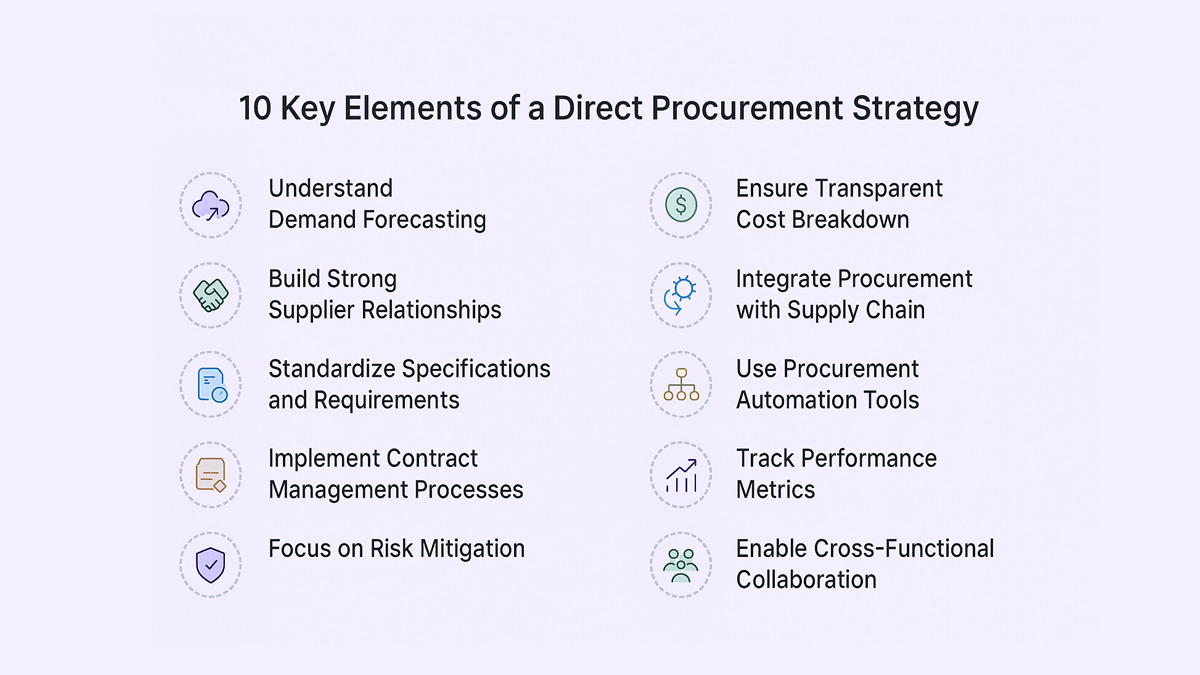

10 Key Elements of a Direct Procurement Strategy: Expert Insights

10 Key Elements of a Direct Procurement Strategy: Expert Insights
Explore 10 essential elements of a direct procurement strategy to reduce costs, ensure supply continuity, and improve supplier performance.


According to Deloitte, nearly 60% of supply chain leaders say poor visibility in direct procurement leads to higher costs and production delays. That number alone shows how vital it is to get procurement right.
Direct procurement isn’t just about buying materials, it’s about ensuring business continuity. When managed strategically, it can reduce costs, improve quality, and secure supply. Let’s look at what makes a strong direct procurement strategy and why it matters for every organization today.
What is Direct Procurement Strategy?
A direct procurement strategy is a planned method for sourcing raw materials or goods that go directly into production. It focuses on ensuring timely supply, controlling costs, and maintaining quality by aligning purchasing decisions with the company’s operational goals.
Why is Direct Procurement Strategy Important
A strong direct procurement strategy is more than just smart buying - it’s a competitive lever. Here are the key reasons why businesses prioritize it:

Ensures Uninterrupted Production
Direct procurement is at the heart of production. Any delay or mismatch can halt operations. A reliable strategy ensures raw materials arrive on time, avoiding costly downtime and production bottlenecks.
Improves Supplier Collaboration
Strategic procurement builds long-term partnerships with suppliers. This leads to better communication, improved contract terms, and shared goals - ultimately reducing friction in the supply chain.
Drives Cost Efficiency
By negotiating prices, consolidating purchases, and minimizing last-minute sourcing, businesses can significantly cut procurement costs. Predictable spend leads to better budgeting and fewer surprise expenses.
Strengthens Quality Control
Proactive procurement helps companies work with vetted suppliers, standardize specifications, and ensure that what comes in meets exact requirements - reducing defects and ensuring end-product quality.
Components of a Direct Procurement Strategy
A strong direct procurement strategy is built on a mix of operational and strategic components. Each plays a role in ensuring consistent supply, cost control, and production efficiency. Here’s a breakdown of the key parts:
Core Components
- Needs Assessment: Identify the exact materials, components, or goods required for production.
- Supplier Identification and Evaluation: Research and assess suppliers based on quality, pricing, reliability, and sustainability.
- Sourcing and Negotiation: Create a sourcing plan and negotiate contracts that secure competitive rates and favorable terms.
- Purchase Order and Contract Management: Draft and manage contracts that align with business goals and ensure supply reliability.
- Logistics and Delivery: Oversee transportation, warehousing, and delivery to maintain on-time supply.
- Supplier Performance Monitoring: Track supplier performance regularly to maintain quality, efficiency, and compliance.
Strategic and Foundational Components
- Strategic Alignment: Make sure the procurement approach supports overall business objectives and long-term goals.
- Risk Management: Minimize potential disruptions by diversifying suppliers and monitoring geopolitical or financial risks.
- Technology Integration: Use digital procurement tools to automate tasks, analyze data, and gain real-time visibility.
- Cross-Functional Alignment: Encourage collaboration between procurement, production, finance, and other teams to improve decision-making.
- Sustainability: Build environmental and social responsibility into sourcing and supplier management practices.
- Continuous Improvement: Regularly review performance and identify new opportunities to refine procurement processes.
10 Key Elements of a Direct Procurement Strategy
Creating a strong direct procurement strategy takes more than experience, it requires structure, foresight, and close collaboration across teams. Here are ten core elements that define a cost-driven direct procurement approach and its impact on both operations and margin.

1. Understand Demand Forecasting
Procurement starts with data, not a purchase order. Accurate demand forecasting helps anticipate what materials are needed, how much, and when. When aligned with production schedules, it reduces excess inventory, avoids shortages, and supports steady production. This accuracy keeps Cost of Goods Sold (COGS) predictable, improving Gross Margin stability.
Pro tip: Combine historical data with real-time inputs from sales and production for more accurate forecasts.
2. Build Strong Supplier Relationships
Reliable suppliers are the foundation of cost control. Long-term partnerships lead to better pricing, dependable delivery, and shared process improvements. These relationships help keep COGS consistent while reducing the risk of sudden cost fluctuations that can erode Gross Margin.
Watch out: Avoid over-dependence on one supplier. Maintain a secondary vendor list to safeguard supply continuity.
3. Standardize Specifications and Requirements
Clarity drives efficiency. Standardizing specifications ensures every team member and supplier understands exactly what’s required. It simplifies comparisons, improves quote accuracy, and prevents production delays, all of which help manage direct costs effectively.
Pro tip: Keep a central spec sheet for frequently purchased items to save time and maintain consistency.
4. Implement Contract Management Processes
Contracts are the foundation of direct procurement discipline. Clear terms on pricing, delivery, and quality protect margins and prevent surprises that can inflate COGS. Regular contract reviews help procurement teams stay aligned with business goals and changing market rates.
Watch out: Don’t treat contracts as static documents. Revisit them regularly to ensure terms remain competitive.
5. Focus on Risk Mitigation
Supply chain disruptions can directly increase production costs. A sound procurement strategy identifies potential risks and builds contingency plans, such as dual sourcing or regional diversification. This not only secures material availability but also protects margins from unexpected cost spikes.
Pro tip: Include financial and geopolitical risk assessments in supplier evaluations.
6. Ensure Transparent Cost Breakdown
Visibility into cost components, from raw materials to logistics, reveals opportunities to reduce COGS. A transparent cost structure also gives procurement stronger negotiation leverage and enables more accurate margin forecasting.
Watch out: Watch for hidden or bundled fees. Always request itemized quotes.
7. Integrate Procurement with Supply Chain
Direct procurement impacts every part of the production cycle. Integrating it with supply chain management ensures synchronized planning, reduces idle time, and minimizes storage costs, all improving operational efficiency and protecting Gross Margin.
Pro tip: Use shared dashboards that link procurement, logistics, and production data for better coordination.
8. Use Procurement Automation Tools
Automation helps teams manage cost-driven direct procurement with precision. Digital tools streamline sourcing, contract approvals, and supplier management while reducing manual errors. Real-time analytics also give visibility into COGS trends and margin impact.
Watch out: Choose tools that integrate with your ERP or financial systems to link procurement decisions with margin outcomes.
9. Track Performance Metrics
Performance tracking is how procurement connects to financial results. Monitor KPIs such as cost savings, lead times, and supplier reliability, and link these directly to Gross Margin improvements. Direct procurement affects COGS, while indirect spend influences OpEx. Tracking both helps identify where your cost-control efforts deliver the most value.
Pro tip: Focus on metrics that show impact on margin and COGS, not just operational efficiency.
10. Enable Cross-Functional Collaboration
Procurement affects finance, production, and quality, and should never work in isolation. Collaborative planning ensures every purchase aligns with production needs, budget goals, and margin targets. When procurement and finance work together, companies can make smarter trade-offs between COGS and OpEx to optimize overall profitability.
Watch out: Bring finance and operations into key sourcing discussions early. It ensures every decision supports Gross Margin improvement.
Direct vs. Indirect Procurement: Key Differences at a Glance
Understanding the difference between direct and indirect procurement helps organizations manage spend effectively, align systems, and focus resources where they matter most. While both aim to control costs and improve efficiency, their objectives, stakeholders, and financial impact differ in critical ways.
Here’s a clear comparison of how direct procurement and indirect spend differ across key dimensions:
How Spendflo Helps with Direct Procurement Optimization
Many businesses lose margin not because of poor sales, but because of inefficiencies buried in their direct procurement processes. Missed renewals, slow approvals, and fragmented supplier data quietly inflate COGS and squeeze Gross Margin.
One of our clients, a mid-market SaaS company, reduced procurement cycle time by 40% and cut redundant vendor spend by $500K annually after switching to Spendflo, proving that visibility and automation directly translate to savings. Yet, for many teams, the challenge remains the same: too many suppliers, too little time, and constant pressure to meet production demand without raising costs.
Spendflo brings clarity and control to that chaos. With centralized data, contract intelligence, and AI-driven sourcing, it helps finance and procurement teams simplify direct spend, improve supplier reliability, and protect margins.
Ready to optimize your direct procurement strategy? Book a demo with Spendflo today.
Frequently Asked Questions on Direct Procurement Strategy
What are the benefits of having a direct procurement strategy?
A defined strategy ensures better cost control, fewer delays, improved supplier performance, and higher-quality inputs - all of which directly impact business outcomes and operational continuity.
How does direct procurement differ from indirect procurement?
Direct procurement involves sourcing goods and materials that are part of the final product, while indirect procurement covers support items like office supplies, software, or services not tied to production.
Can automation improve direct procurement processes?
Yes. Automation helps speed up tasks like PO generation, invoice matching, and vendor evaluation while improving accuracy and reducing manual errors or compliance risks.
What are the challenges of implementing a direct procurement strategy?
Common challenges include inaccurate forecasting, siloed communication between departments, supplier risks, lack of real-time data, and outdated manual processes.
How does procurement software enhance supplier relationship management?
Procurement software centralizes supplier data, tracks performance, and automates communication - helping teams manage contracts, evaluate vendor reliability, and strengthen long-term supplier relationship management through better visibility and collaboration. Clear agreement on payment terms also helps reduce friction and avoid late payment disputes.
Why is risk management essential to maintaining product quality during supply chain disruptions?
Strong risk management practices help businesses prepare for and respond to supply chain disruptions, ensuring product quality doesn’t suffer. By enforcing quality standards and managing vendor risks, companies can avoid delays, defects, or costly emergency sourcing decisions.










.png)




.png)










.avif)





